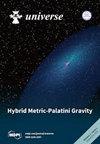Predicting Solar Cycles with a Parametric Time Series Model
IF 2.5
4区 物理与天体物理
Q2 ASTRONOMY & ASTROPHYSICS
引用次数: 0
Abstract
The objective of this paper is to reproduce and predict the series of solar cycle amplitudes using a simple time-series model that takes into account the variable time scale of the Gleissberg oscillation and the absence of clear evidence for odd–even alternation prior to Solar Cycle 9 (SC9). It is demonstrated that the Gleissberg oscillation can be quite satisfactorily modelled as a sinusoidal variation of constant amplitude with a period increasing linearly with time. Subtracting this model from the actual cycle amplitudes, a clear even–odd alternating pattern is discerned in the time series of the residuals since SC9. For this period of time, the mean value of the residuals for odd-numbered cycles is shown to exceed the value for even-numbered cycles by more than 4σ, providing the clearest evidence yet for a persistent odd–even–odd alternation in cycle amplitudes. Random deviations from these means are less than half the standard deviation of the raw cycle amplitude time series for the same period, which allows the use of these regularities for solar cycle prediction with substantially better confidence than the simple climatological average. Predicted cycle amplitudes are found to be robust against the addition or omission of some data points from the input set, and the method correctly hindcasts SC23 and SC24. The potential physical background of the regularities is also discussed. Our predictions for the amplitudes of SC25, SC26, and SC27 are 155.8±20.7, 96.9±25.1 and 140.8±20.7, respectively. This suggests that the amplitude of SC26 will be even lower than that of SC24, making it the weakest cycle since the Dalton Minimum.用参数时间序列模型预测太阳周期
本文的目的是利用一个简单的时间序列模型来重现和预测太阳周期振幅序列,该模型考虑到了格来斯伯格振荡的时间尺度可变,以及在太阳周期 9(SC9)之前缺乏奇偶交替的明确证据。研究表明,格来斯伯格振荡可以非常令人满意地模拟为振幅恒定、周期随时间线性增加的正弦变化。从实际周期振幅中减去这个模型,可以在 SC9 后的残差时间序列中发现明显的偶数-多 数交替模式。在这段时间内,奇数周期的残差平均值比偶数周期的残差平均值高出 4σ 以上,这为周期振幅持续存在奇偶偶交替提供了最清晰的证据。这些平均值的随机偏差小于同期原始周期振幅时间序列标准偏差的一半,这使得利用这些规律性进行太阳周期预测的可信度大大高于简单的气候学平均值。预测的周期振幅对从输入集中添加或省略某些数据点具有鲁棒性,而且该方法能正确后报 SC23 和 SC24。我们还讨论了这些规律性的潜在物理背景。我们对 SC25、SC26 和 SC27 振幅的预测分别为 155.8±20.7、96.9±25.1 和 140.8±20.7。这表明,SC26的振幅将比SC24的振幅更低,成为道尔顿极小期以来最弱的周期。
本文章由计算机程序翻译,如有差异,请以英文原文为准。
求助全文
约1分钟内获得全文
求助全文
来源期刊

Universe
Physics and Astronomy-General Physics and Astronomy
CiteScore
4.30
自引率
17.20%
发文量
562
审稿时长
24.38 days
期刊介绍:
Universe (ISSN 2218-1997) is an international peer-reviewed open access journal focused on fundamental principles in physics. It publishes reviews, research papers, communications, conference reports and short notes. Our aim is to encourage scientists to publish their research results in as much detail as possible. There is no restriction on the length of the papers.
 求助内容:
求助内容: 应助结果提醒方式:
应助结果提醒方式:


